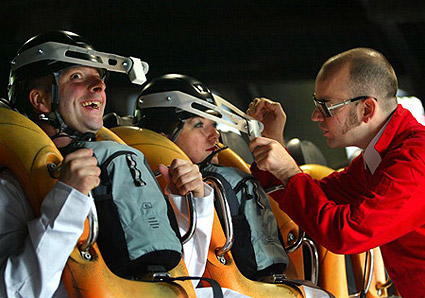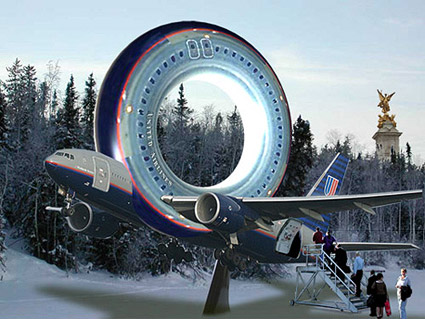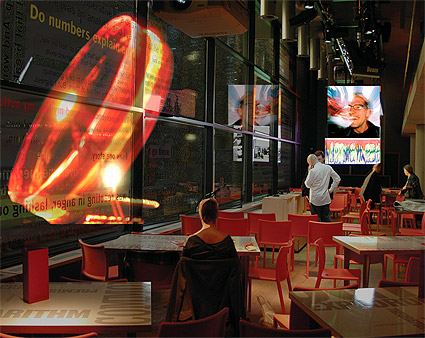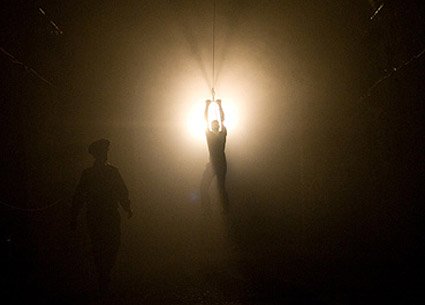A tidbit from the recent This Happened in London, where Semitransparent Design from Japan, Matt Jones and Russell Davies, Simon Oliver and Brendan Walker gave some insights in the inner workings of their recent projects.
 Brendan Walker as Thrill Engineer
Brendan Walker as Thrill Engineer
Brendan calls himself a thrill researcher and engineer, and his design practice Aerial is “specialising in the creation of tailored emotional experience”. This might sound a bit like standard lingo at first, but they actually mean it, since they’re not looking at aesthetic pleasure from glitzy bathrooms or glossy interfaces, they’re talking death-defying experiences, screams and cold sweat. This is an interesting subject for design since we are living in a time where often the emotional aspects of an object can be as important as the item itself, with people attributing cuteness to robots and such.
Originally trained as an aircraft engineer, he soon realized that there’s more to flying than just getting from A to B. Especially fairground or theme park-rides often aim to produce the same feeling that you had when that jet you were on suddenly dropped a few hundred meters. Thrill Laboratories looked at the way roller coasters are created as scripted experiences: people usually undergo a series of feelings when on the ride, which often enough (think of the ones that pretend to be over and then comes the real drop) follow a narrative almost like in a film.
 Airlife, Seatbelts from the Chromo11 project
Airlife, Seatbelts from the Chromo11 project
To get a grip on the world of thrills, Walker teamed up with a criminologist from UCLA in Los Angeles to create the Taxonomy of Thrill and Thrilling Designs, two publications which try to formalize the aspects of the experience of being thrilled. And because this is proper research, they even created thrill-equations which include variables like euphoric value, valence polarity or the strong emotion coefficient.
Having that somewhat formalized, Thrill Labs and a gentleman named James Conran teamed up and applied for one of the British Wellcome Trust’s grants to create a harness which can be stripped to people on rides and would capture their emotions. “The technology for recording extreme emotions is there, it’s just a question of bolting together the right parts”. So they did and successfully created a setup which allows to record audio, video and different vital signs like the heart rate of someone on a ride, as well as their current acceleration.

Mockup of Fairground: Thrill Laboratory at Dana Centre
After demoing this device, they were approached by London Science Museum’s Dana Centre to create a three-week Fairground show which would include three “classic British fairground rides”, the Miami Trip, the Ghost Train and the Booster to their venue in South Kensington. Each ride exploring a slightly different theme (pleasure, frisson and visceral delights), the main challenge was how to convey the subjects’ experience on the rides in the yard to the audience inside the Centre. Dressed like Russian engineers in red overalls, Brendan and his colleagues from Shunt created a whole “carnival of experimentation” around the rides. The the images and data from individuals on the rides was streamed into the center (with wi-fi dropouts unintentionally but effectively adding to the drama) where there it was just displayed upstairs and interpreted by an expert downstairs.
Footage from Oblivion: Thrill Laboratory
Since then, there has been increasing interest in the research of thrill, with the Fairground performance being repeated at the iconic Oblivion ride at Alton Towers, which claims to be the world’s first vertical drop roller coaster. There Brendan worked with a team of psychologists to survey 80 riders and collect their data into what became “a real monster of information”. This eventually hints at the more serious side of thrills-there is a big market for developing technology and methodology of these extreme experiences. There has been little research so far in that area, especially in terms of design since most of these rides more or less stand upon 100 years of tacit knowledge and not rules and methodology.
A robo coaster
The ultimate goal, of course, would be designing a cybernetic ride with actual biofeedback from the individuals on it, always adapting the ride to their emotions and sensations. A little hint of that might be the internet-infamous robo coasters, some of which are already in use at Legoland California.
 Airphoria: Terminal 2 at Shunt
Airphoria: Terminal 2 at Shunt
And, for everyone who wants to have a controlled near-death experience of their own: Brendan and Thrill Laboratories will perform their Airphoria: Terminal 3, a.k.a. The Death Slide, this Friday (11th) evening at Shunt in London, which is located under the arches of London Bridge. Go scream!
Related story: Thrill Laboratory.
